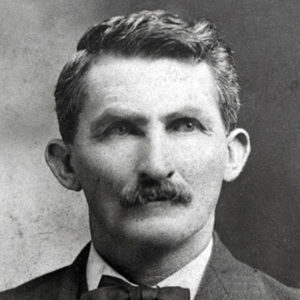calsfoundation@cals.org
Erasmus Irving (Ras) Stirman (1839–1914)
Arkansas native Erasmus Irving Stirman was a Confederate colonel during the Civil War who, after the hostilities, became a successful politician and lawyer.
Erasmus Irving Stirman was born in Benton County on April 16, 1839, soon after his parents, Alfred Addison Stirman and Pauline Fry Stirman, had crossed the state line, moving from Palmyra, Missouri, to Fayetteville (Washington County), where they would establish a mercantile business.
Ras Stirman was orphaned at a young age but attended Arkansas College in Fayetteville and worked as a store clerk as he studied to prepare to attend the U.S. Naval Academy at Annapolis, Maryland. Those plans ended when Arkansas seceded from the Union, and he enlisted as a sergeant in the “Pike Guards,” which later became a company in the Third Arkansas Infantry in the Arkansas State Troops.
After fighting in the Battle of Wilson’s Creek in Missouri, Stirman mustered out of the state troops on September 1, 1861, and joined William H. Brooks’s Company E of the First Arkansas Cavalry Battalion as a second lieutenant; he become the company’s captain after Brooks was promoted to major. After fighting in the March 1862 Battle of Pea Ridge, the battalion moved east of the Mississippi River with the rest of Major General Earl Van Dorn’s Army of the West.
The First Arkansas was dismounted and renamed the First Battalion of Sharpshooters on July 10, 1862, and Stirman was made its lieutenant colonel; the unit was designated Stirman’s Regiment of Sharpshooters on August 1. It was disbanded after suffering heavy casualties in the October 3–4, 1862, Battle of Corinth, Mississippi. Stirman was granted a sick leave furlough in the spring of 1863 and was not present when the rest of his old battalion surrendered on July 4, 1863, at Vicksburg, Mississippi.
Rejoining the army in Arkansas, Stirman commanded the post at Dardanelle (Yell County) in late 1863 and fought in the September 12, 1863, skirmish there before raising a new cavalry battalion in early 1864, which included men from the old First Arkansas Cavalry Battalion. Stirman’s horsemen fought Major General Frederick Steele’s Federal army during the Camden Expedition, seeing combat at Prairie D’Ane, Poison Spring, and Marks’ Mills, with Stirman suffering three wounds in the latter battle.
Stirman’s battalion frequently fought alongside Brooks’s cavalry regiment in the latter part of the war, including at the skirmishes at Clarksville in September and October 1864, the November 7–13 Frog Bayou Expedition, and the January 1865 actions at Dardanelle and Ivey’s Ford. When the war ended, Stirman surrendered to Brigadier General Cyrus Bussey in Fort Smith (Sebastian County) in May 1865.
Returning to Fayetteville, Stirman was elected the town’s mayor after his former foe, Marcus LaRue Harrison, was ousted from the position. He attended the University of Kentucky, graduating with a law degree in 1869.
He married Marium Gist the following year, and they moved back to Fayetteville; the couple would have ten children. They built an imposing house on North College Street that would later be owned by University of Arkansas president John C. Futrall.
Stirman was elected Washington County judge in 1874 and, a year later, became district attorney for an eight-county area. In 1879, the Stirmans moved to Colorado, hoping the climate would be better for him as he suffered from his old war wounds. He practiced law there while also being active in politics, serving as mayor of Lake City and as a state representative in the general assembly. The family later moved to Denver, where he worked as a lawyer until “the wounds he received during the Civil War…greatly impaired his health and compelled him to retire from the active practice of law.”
Stirman returned to Arkansas at least once to attend the 1911 United Confederate Veterans reunion in Little Rock (Pulaski County). He died of pneumonia at his son’s house in Denver on January 4, 1914. One old comrade remembered him as “very popular with his men and…a gallant soldier,” while another wrote that “no braver soldier than Colonel Stirman fought on either side.” The Denver Bar Association eulogized him as “a true man, a loyal friend, a tender and loving husband and father.” He is buried in Fairmount Cemetery in Denver.
For additional information:
Allardice, Bruce S. Confederate Colonels: A Biographical Register. Columbia: University of Missouri Press, 2008.
“Col. E. I. Stirman.” Arkansas Gazette, January 10, 1914, p. 9.
“Col. E. I. Stirman Dies in Denver.” Arkansas Democrat, January 10, 1914, p. 2.
“Col Erasmus Irving Stirman.” Find a Grave. https://www.findagrave.com/memorial/35160831/erasmus-irving-stirman (accessed December 8, 2023).
“Colonel ‘Ras’ Stirman.” Flashback 4 (May 1954): n.p.
“Erasmus Irving Stirman.” Flashback 7 (January 1957): 18–21.
“Erasmus Stirman.” Community and Conflict: The Impact of the Civil War in the Ozarks. https://ozarkscivilwar.org/archives/619 (accessed December 8, 2023).
In Fine Spirits: The Civil War Letters of Ras Stirman with Historical Comments by Pat Carr. Fayetteville, AR: Washington County Historical Society, 1986.
Mark K. Christ
Central Arkansas Library System
 Civil War through Reconstruction, 1861 through 1874
Civil War through Reconstruction, 1861 through 1874 Military
Military Politics and Government
Politics and Government Erasmus Stirman
Erasmus Stirman 




Comments
No comments on this entry yet.